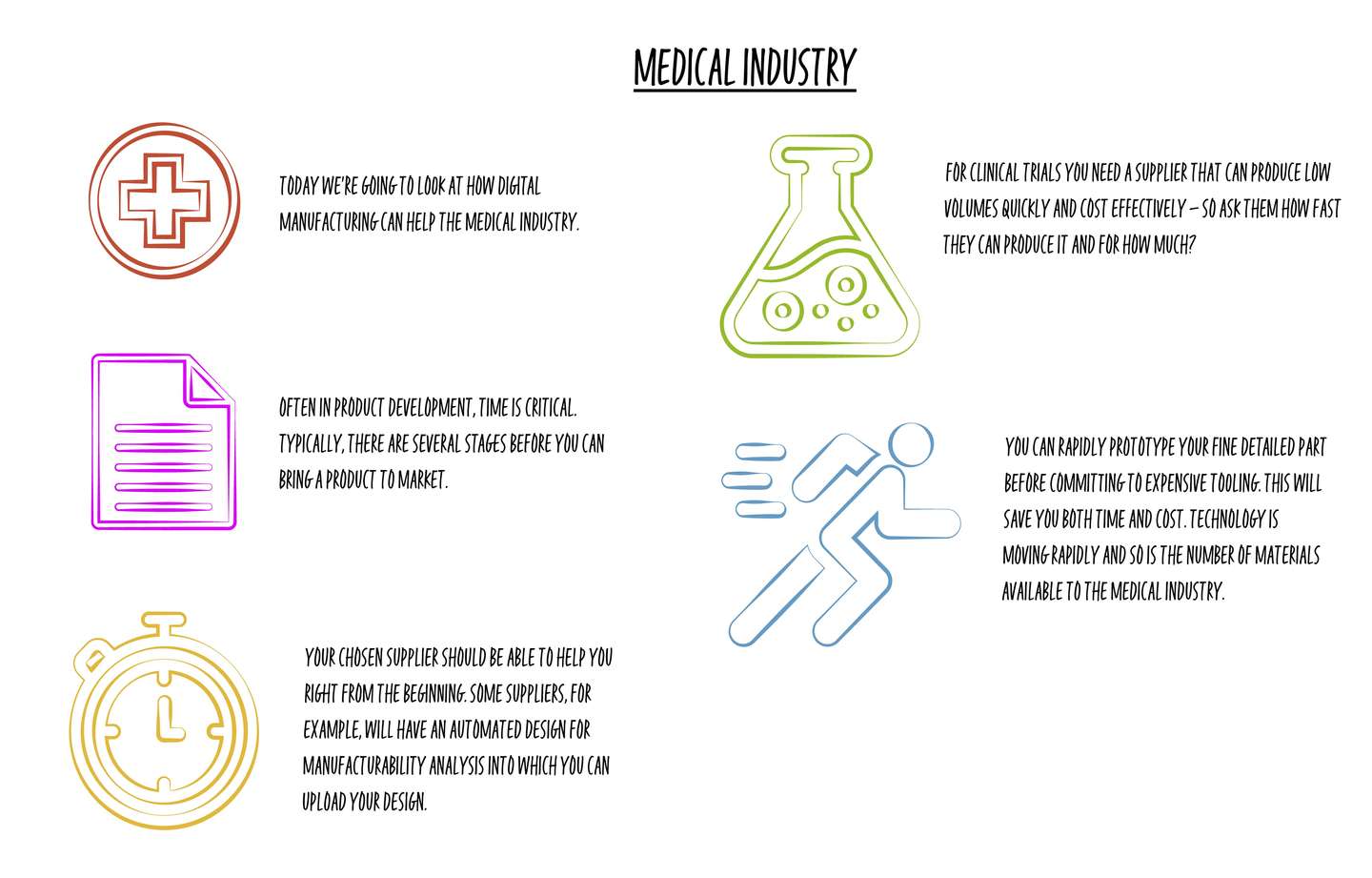
Medical Industry
Your masterclass in product design and development
Protolabs’ Insight video series
Our Insight video series will help you master digital manufacturing.
Every Friday we’ll post a new video – each one giving you a deeper Insight into how to design better parts. We’ll cover specific topics such as choosing the right 3D printing material, optimising your design for CNC machining, surface finishes for moulded parts, and much more besides.
So join us and don’t miss out.
Insight: Medical Industry
Transcript
Hello and welcome to this week’s Insight.
Today we’re going to look at how digital manufacturing can help the medical industry.
Whether it’s prototype development and testing, low volume production of products for clinical trials or even 3D printing body parts for transplant, modern manufacturing technologies have revolutionised what is possible.
So let’s see how this technology can help and look at some of the more common materials used.
We’ll start with how digital manufacturing can make a real difference.

Often in product development, time is critical. Typically, there are several stages before you can bring a product to market. First you need ensure that what you have as a CAD design is attainable as a manufactured part, then you need to test it for function and after that you may have to produce low volumes for clinical trials before moving to mass manufacture.
All these stages take time and can cost a lot of money before you even get to market. The challenge is to shorten your lead times and minimise your costs.
There are three manufacturing technologies that you would typically use for a part; injection moulding, CNC machining or 3D printing.

Your chosen supplier should be able to help you right from the beginning. Some suppliers, for example, will have an automated design for manufacturability analysis into which you can upload your design. Not only will this give you a quote, but it will highlight any areas that you need to adjust for future manufacturing. You can then tweak your design and save yourself a lot of time, cost and heartache later.
When you are happy with the design, your next step will depend on what you want to achieve. If you are after a joint replacement, then check out their 3D printing capabilities and what medical grade materials they have available – but more on that later.
You can also use 3D printing to produce a first protype for form and function testing, although some organisations use CNC machining or even injection moulding at this stage; it really depends what you are after.

For clinical trials you need a supplier that can produce low volumes quickly and cost effectively – so ask them how fast they can produce it and for how much?
Now here’s a good tip, if your supplier offers all three technologies then they can take you through all the steps to speed up the process and ensure that the transition is as smooth as possible.
I admit that that was a bit of a lightning tour of digital manufacturing, but we have covered all of these topics in a lot more detail in previous videos, so it may be worth backtracking and taking a look.
The great thing is the technology is always improving and the number of different materials available to you is increasing all the time. Let’s look at some of the more common ones.
There are of course many different plastics. High temperature plastics such as PEEK and PEI offer high temperature resistance, creep resistance and are ideal for applications that need sterilizing. There are also clear materials that you can use for microfluidic parts and transparent components like lenses and housings.
Recent material developments include resins that are ideal for micro resolution parts with really fine details for specialist equipment. A good example is our Microfine Grey and Green resins that can be 3D printed with fine details as small as 0.07mm.

It means that you can rapidly prototype your fine detailed part before committing to expensive tooling. This will save you both time and cost.
Moving onto metals, between CNC machining and 3D printing there are numerous material options for medical components, instrumentation, patient transplants and other applications.
We really don’t have time to run through all of them. But stainless steels, for example, are corrosion resistant and strong. Cobalt Chrome is another that has excellent corrosion resistance and it is also very wear resistant.
But let’s briefly focus on a material that is very commonly used – Titanium. This metal is very light, strong and wear resistant. It is also considered the most biocompatible of all the metals due to its bio inertness and corrosion resistance to fluids in the body. These make it ideal for implants such as hip or knee replacements.
And now that it can be 3D printed, you can have a new hip or knee that exactly matches what the patient needs at a reasonable price and more quickly. This technology really has revolutionised medicine.
Other materials that are available and commonly used include Carbon RPU and FPU, medical grade silicone rubber and you can now even manufacture parts from pure silicone.
Technology is moving rapidly and so is the number of materials available to the medical industry. Whether you are a product designer or you need a bespoke implant for a patient it is well worth speaking to a specialist supplier. You’ll be amazed at what is now possible.
That’s it for this week. I look forward to seeing you again next Friday.
With special thanks to Natalie Constable.







